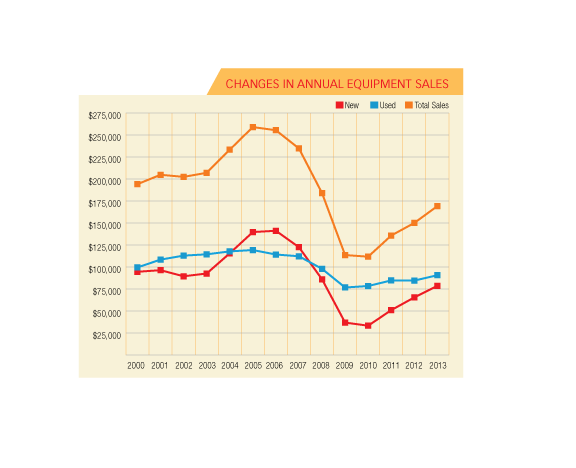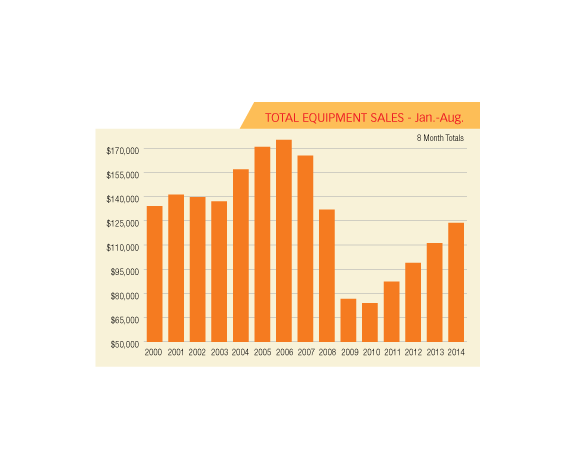Moving Iron - Data on New, Used Equipment Sales
by Mike Martin
When the housing bubble burst in 2007 and ‘08, equipment sales went with it. In fact, data show, new and used equipment sales for 2009 totaled less than half of what sold in 2007, coming in at less than 114,000 units compared to nearly 235,000 just two years earlier (please see the charts).
The data is from Equipment Data Associates, a division of Randall-Reilly, publishers of Equipment World and
other construction and trucking media properties. EDA tracks public Uniform Commercial Code-1 filings, which lenders submit when they finance equipment transactions, covering everything from air compressors to excavators.
While it’s interesting to look at the numbers, recent shifts in new and used equipment seem to show that equipment sales are on a steady upward trajectory in the U.S. This is important for a couple of reasons. First, the rental centers we’ve visited have been saying that they are becoming a more important resource for contractor customers - more of whom are choosing not to own equipment. They’ve cited a few reasons for this:
- Economic uncertainty – given what survivors went through in the Great Recession, contractors are slow to build their fleets, preferring instead to rent.
- Hard costs for smarter bidding – a rental contract gives them solid numbers to work with when bidding a job, adding a degree of certainty that equipment costs are covered by the bid.
- Focus – for some contractors, not having to worry about financing, buying and maintaining equipment removes a distraction. They can focus on bidding more jobs, getting more bids and working to be as productive as possible, while relying on rental centers to keep well-maintained equipment available.
 Second, total equipment rental revenue growth in North America was outpacing the general economy by a factor of three in Q1. While the U.S. economy has improved, the American Rental Association’s Rental Market Monitor, as reported in May of this year, was projecting 7.5 percent growth for 2014, 10.4 percent next year and 9.3 percent in 2016.
Second, total equipment rental revenue growth in North America was outpacing the general economy by a factor of three in Q1. While the U.S. economy has improved, the American Rental Association’s Rental Market Monitor, as reported in May of this year, was projecting 7.5 percent growth for 2014, 10.4 percent next year and 9.3 percent in 2016.
More specifically, the ARA’s analysis noted, construction and industrial equipment revenue is forecast to see a ompounded Annual Growth Rate of 8.6 percent between 2014 and 2018 in North America. If these trends hold, it means increased demand for what you offer.
Tracking sales through two recessions, one bubble
With that background, take a look at the sales data on the next page. We provided two charts using the numbers from EDA. The first looks at annual used, new and total equipment sales numbers for 2000 through 2013. Taking this long-term, rearview-mirror look, it’s interesting to look at equipment sales, particularly in relationship to post-recession recovery.
The U.S. slipped into a recession in early 2001 that ran almost through November of that year. With the terrorist attack on 9/11, recovery was slow. Equipment sales reflected the overall economic doldrums, staying relatively flat through 2003. Looking at monthly sales data, in that three-year span, there were only eight months where new equipment sales outstripped sales of used.
As the housing market heated up, along with all of the related infrastructure required to serve new homes and condos, equipment sales rolled. Total sales grew about 12% in 2004 compared to 2003. In mid-2004, new equipment sales started to outpace used sales. In 38 of the 48 months running from January 2004 through December 2007, new equipment sales were greater than used equipment.  When this article was written, EDA had through-August data for 2014. For comparison, we pulled the numbers for the first eight months of each year from 2000 to 2014. The data, although it could change as more UCC-1 filings come in, show that in four of the past five months (April – September) new equipment sales were higher than used equipment sales. That hasn’t happened since 2007. While five months do not a trend make, it certainly suggests that used and new equipment sales, at least for now, are on a solid upward path.
When this article was written, EDA had through-August data for 2014. For comparison, we pulled the numbers for the first eight months of each year from 2000 to 2014. The data, although it could change as more UCC-1 filings come in, show that in four of the past five months (April – September) new equipment sales were higher than used equipment sales. That hasn’t happened since 2007. While five months do not a trend make, it certainly suggests that used and new equipment sales, at least for now, are on a solid upward path.
Increased utilization = older rental fleets?
That noted, it’s safe to say the equipment market can be fluid. We asked Ritchie Brothers Auctioneers what they’ve being seeing when it comes to rental centers. According to Doug Olive, vice president, Pricing and Valuations for the company, you’re staying busy and holding onto your equipment – for good reason. “Utilization rates are high with rental companies, based on the customer base we work with,” he comments. “Rental centers have not been able to turn equipment at the same rates because it is out there being used.”
After 2007, fleets were trimmed, quickly, pushing a lot of equipment into the market. Olive couldn’t say if this excess inventory was declining. He did, however, point out that “the age of used equipment sold at our auctions is getting newer in the used side right now. We are seeing more of one, two and three-year-old equipment than in past years, after manufacturing was cut in half during the recession and post-recession period.” Post recession meaning 2009 – 2011.
With the amount of equipment they move, Olive keeps a sharp eye on the dollars paid at the company’s auctions. “Coming into 2014, pricing was strong for well-maintained used equipment. It has begun to flatten out somewhat on certain asset classes as we enter the third quarter,” he says.
Prices are tracking with demand, he says, “With construction and job rates up, demand is higher than last year. That being said, it has leveled off as we entered the third quarter.” Still, the company is seeing more people lining up to bid. While they don’t provide numbers, Olive explains that they’ve seen “an incremental percentage increase over last year.”
More potential buyers, more newer used equipment being sold, but currently flatter demand? There’s a chance that equipment sales, like housing starts, have yet to find full traction. It’s worth keeping an eye on these trends, though, as you consider making changes or additions to your fleet.









